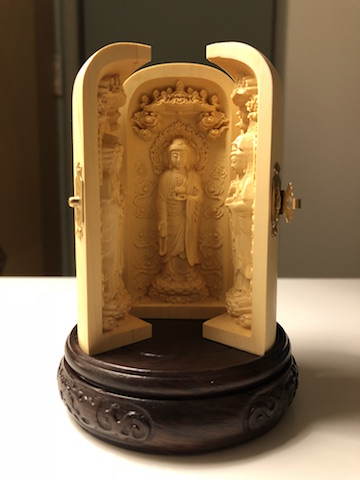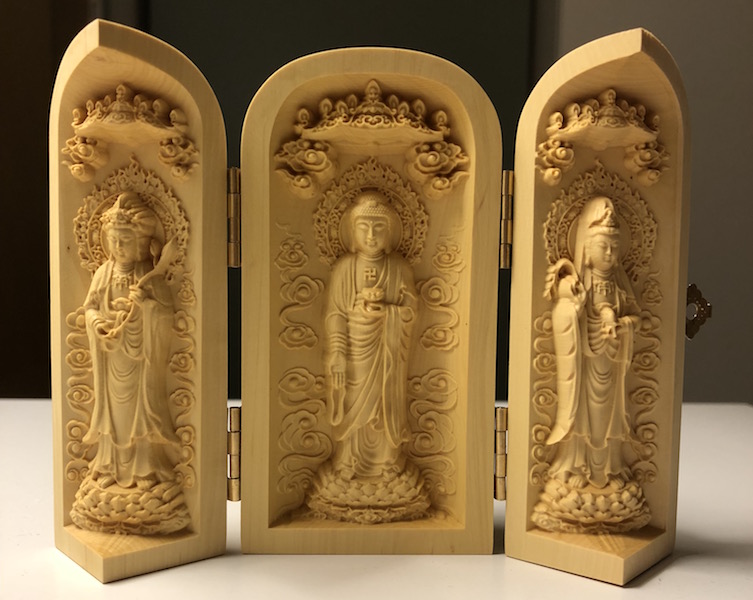I have a beautiful portable shrine that is dedicated to the worship of Amitabha Buddha, the central Buddha of the Pure Land school and the most popular object of reverence in Chinese Buddhism. Owners of a shrine this size can take it anywhere around the world with them. Elegantly carved out of wood, it fits in the palm of my hand when locked up and is small enough to be put inside even a handbag or purse. Open the three compartments, however, and it reveals the Pure Land triad of Amitabha (extending his hand in the mudra or hand position of laiying or raigo, welcoming the devotee into the Pure Land. Flanking him are Avalokiteshvara (Guan Yin) and Mahasthamaprapta (Da Shi Zhi), his attendant bodhisattvas.
The compartments of this private shrine can be arranged to either face the worshipper directly or on a small altar, in a manner similar to the Buddhist caves of old in locales like Ajanta, Kizil, or Dunhuang (as seen below). It’s particularly useful for worshippers who are short on space, who travel often, or simply want the convenience of a low-maintenance shrine. It can even be placed by your bedside, as the representation of a transcendent presence.
Portable shrines (called zushi 厨子 in Japan) constitute an ancient Buddhist tradition of worship. They aren’t the only compact, transportable religious items that Buddhism offers: in Asia it is common for sutras, dharanis, and mantras to be printed on extremely small pieces of paper and rolled into a tube to be fitted as the centrepiece of a necklace, not to mention amulet and Buddha image necklaces. In Vajrayana Buddhism, thangkas can be easily rolled up and put on the backs of animals of labour, taken across great distances or inhospitable environments like snowy mountains or the great deserts of Inner Asia. But portable shrines have been around since the days of at least the transmission of Buddhism along Silk Road (the opening centuries of the Common Era), when monks and lay Buddhists like merchants and travellers were moving constantly.
While Buddhism has locales of pilgrimage and holy sites like most other religions, Buddhists have believed for millennia in the idea of “portable sanctity”: that the Dharma is not restricted to any physical location, but can be transmitted and diffused into any region or locale where Buddhists go to or live. This is related to the idea that Buddhism, while perhaps not having as “missionary” a reputation as other traditions, still sees itself as a universal religion, relevant to all peoples and all cultures at all times and places. As Won Buddhism author Chung Bongkil wrote in 1991: “This portable sanctity, that is the quality of being sacred or hallowed, did not depend on mass migration or invasion of armies. Neither was it only a movement of religious ideas from a developed culture into a primitive environs. Buddhism was able to spread from lndia into one of the most sophisticated cultures of the world, China. This portable aspect of Buddhism allowed it to escape from the cultural boundaries of the Ganges Valley and to become a part of social and religious life throughout Asia.”
 Another related concept is the journey of the interior, because Buddhism is a religion of insight (seeing through the illusory cosmos) rather than strictly of revelation (divine decrees revealed to humanity). There is no demand to travel to a central pilgrimage spot like Mecca as a compulsory matter or “pillar of faith.” As an insight religion, your inner transformation and attainment of the enlightened mind is invisible to others. Religious paraphernalia, almost by necessity, is convenient and meant to facilitate your needs on your personal path.
Another related concept is the journey of the interior, because Buddhism is a religion of insight (seeing through the illusory cosmos) rather than strictly of revelation (divine decrees revealed to humanity). There is no demand to travel to a central pilgrimage spot like Mecca as a compulsory matter or “pillar of faith.” As an insight religion, your inner transformation and attainment of the enlightened mind is invisible to others. Religious paraphernalia, almost by necessity, is convenient and meant to facilitate your needs on your personal path.
From Central Asia to the Korean peninsula, from the Pontic-Caspian Steppe to the Indonesian archipelago, Buddhism was perhaps the first world religion to consciously move beyond family, ethnicity, language, culture, geography, and social structures as it became the first religion to not be violently imposed by empire-builders, but rather adopted by empire-builders because of its universality. Now in the contemporary world, we have more ways than ever of conceiving of portable sanctity: through digitized images and texts, through cultural adaptation in the West and the infusion of truly local concerns with the broader practice of Dharma.
For we must never forget why Buddhist clergy and householders, from the most ancient of days, advocated portable sanctity in the first place. The world is your temple.
Related features from Buddhistdoor Global
The Art of Salvation: The “Descent of Amitabha” Motif in Pure Land Art


